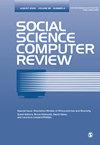Learning to Live with COVID-19: Informative Fictions of TikTok Misinformation and Multimodal Video Analysis
IF 2.7
2区 社会学
Q2 COMPUTER SCIENCE, INTERDISCIPLINARY APPLICATIONS
引用次数: 0
Abstract
The spread of misinformation has historically been attributed to emotions, thinking styles, biases, and predispositions, but only a few studies have explored the conditions influencing its prevalence. The Theory of Informative Fictions (TIF) addresses this gap by presenting propositions that predict the conditions under which misinformation is tolerated and promoted. Building on the literature on TIF and deep learning, we uncover how property messages and character messages differ in veracity and explore the relationship between visual misinformation and user engagement. By constructing a short video dataset Tikcron (学习与COVID-19共存:TikTok错误信息的信息虚构和多模态视频分析
错误信息的传播历来被归因于情绪、思维方式、偏见和倾向,但只有少数研究探讨了影响其流行的条件。信息虚构理论(TIF)通过提出预测错误信息被容忍和推广的条件的命题来解决这一差距。基于TIF和深度学习的文献,我们揭示了属性信息和字符信息在准确性上的差异,并探索了视觉错误信息与用户参与度之间的关系。通过构建短视频数据集Tikcron (N = 42,201)和多模态视频分析框架KILL,我们将TikTok视频分为虚假信息和属性消息或字符消息。我们的研究结果表明,字符信息比属性信息更容易传达错误信息,而带有错误信息的字符信息比带有错误信息的属性信息更容易得到社交媒体用户的容忍和推广。本研究将目前“图像即数据”的方法论进展扩展到错误信息视频,并提出了一个多模态视频分析框架,以发展以传播为中心的理论。本研究对视觉错误信息的检测、反击和治理的更广泛的实际意义也进行了讨论。
本文章由计算机程序翻译,如有差异,请以英文原文为准。
求助全文
约1分钟内获得全文
求助全文
来源期刊

Social Science Computer Review
社会科学-计算机:跨学科应用
CiteScore
9.00
自引率
4.90%
发文量
95
审稿时长
>12 weeks
期刊介绍:
Unique Scope Social Science Computer Review is an interdisciplinary journal covering social science instructional and research applications of computing, as well as societal impacts of informational technology. Topics included: artificial intelligence, business, computational social science theory, computer-assisted survey research, computer-based qualitative analysis, computer simulation, economic modeling, electronic modeling, electronic publishing, geographic information systems, instrumentation and research tools, public administration, social impacts of computing and telecommunications, software evaluation, world-wide web resources for social scientists. Interdisciplinary Nature Because the Uses and impacts of computing are interdisciplinary, so is Social Science Computer Review. The journal is of direct relevance to scholars and scientists in a wide variety of disciplines. In its pages you''ll find work in the following areas: sociology, anthropology, political science, economics, psychology, computer literacy, computer applications, and methodology.
 求助内容:
求助内容: 应助结果提醒方式:
应助结果提醒方式:


